Crunch is an important texture! Especially if you feel like you are getting into a rut of feeling like your foods are toooo mushy all the time in your diet- cooked stuff, smoothies and all :). Crunchy foods can feel fresh and wake up your taste buds. I used to be a huge crunch addict, especially with my beloved pretzels, back in the day. I talk a lot about food cravings in my third book The Beauty Detox Power, I cover what certain cravings mean as well as how to transform them long-term.
But now I want to share how to get your crunchy fix in, with deliciously seasoned veggies! I came up with another salad that has all the goodness and none of the high sodium or bloating ingredients of those addictive snacks out there. My ACV Veggie Quinoa Salad Recipe will fill your gut with beauty veggies and high protein quinoa.
ACV (Apple Cider Vinegar)
Apple cider vinegar is a staple you will want to keep stashed in your kitchen cabinet for many recipes, including today’s.
ACV is made by using active yeast that is combined with sugar—from the naturally occurring sugar from crushed apples. The yeast then consumes the sugar and uses this to grow healthy bacteria (this is how fermentation takes place).
Through much personal research and use, the best apple cider vinegar should be made from certified organic apples and should be sourced raw. Look for brands (like Braggs) that are labeled to include the “mother.” That is, essentially part of the starter culture. Isn’t that a great term?! Pasteurization isn’t required, as this kills all of the delicate nutrients and enzymes.
What I love is that the acidity of the vinegar is enough to prevent unhealthy bacteria (like E. Coli), from developing. Once the fermentation process is complete, the result is the formation of acetic acid—the main beneficial compound found in apple cider vinegar.
This vinegar can be used for anything from curing colds to whitening your teeth. I love using ACV in my recipes because not only does it detoxify your body, but can help balance candida, regulate pH balance, and promote optimal digestion (yesssss). So how does it do all of this?
Well first, apple cider vinegar is actually a liver and lymphatic tonic which can help detox your body. Not only balancing your body’s pH and stimulating cardiovascular stimulation, but helping with bowel motility and lymphatic drainage (and you know I’m all about getting the bowels moving!).
Click here if you want an extra boost in removing unwanted toxins from your gut!
Struggling with candida and/or yeast? The side effects can be a drag, with a lack of energy, UTI’s and digestive issues. Move over side effects! Apple cider vinegar contains beneficial probiotics and other compounds to help balance yeasts in your body- including candida.
In The Beauty Detox Solution I provide more on how to incorporate ACV into your diets and a comprehensive candida program in general.
Helping to balance your pH level overall helps promote bone health and overall wellness. And though apple cider vinegar contains acetic acid—being acidic in nature—upon digestion its overall effect on your body is alkalizing.
As far as promoting digestion, ACV does so by encouraging growth of friendly bacteria in your body. There is this age-old digestion remedy calls for sipping one tablespoon of raw apple cider vinegar, diluted in a cup of water twenty minutes before meals. You can give this a go but I prefer to use it in my salads as in dressing, and tossing it into some of my other savory dishes. I personally am more of an eater than a drink of ACV, but if you like sipping it yourself, then by all means go for it!
When it comes to buying this powerful vinegar, again, be sure to purchase a brand that is labeled “raw” and “unfiltered”. Personally, I like using Bragg’s Organic Raw-Unfiltered Apple Cider Vinegar.
Fresh Local Veggies
Though summer has been winding down, hopefully your local farmers market will still be going strong into the fall, so please do take full advantage. Nothing feels more amazing than choosing and purchasing your very own veggies and actually eating them. With our busy lives, it couldn’t be any healthier or simpler, for you and your family.
In order to make ourselves the healthiest and naturally beautiful is by supporting our body’s efforts to stay at its perfect, slightly alkaline pH by making the best food choices in our day-to-day life. We want to strive to be conscious of which foods will leave an alkaline residue and which leaves an acidic residue in our body.
What is alkaline pH? The balance between alkalinity and acidity is referred to as pH (“power of hydrogen”), which reflects the concentration of hydrogen ions in any give situation. The pH scale ranges from totally acidic (at 0.00), to totally alkaline (14.0), making 7.0 neutral. The higher the pH number of something over 7.0, the more alkaline it is (I go into this topic in greater detail in the Beauty Detox Solution book).
All foods leave either an alkaline or an acidic residue in the bloodstream, and how our body breaks down food is critical in what residue that food leaves behind. The foods that have the most benefit and residue are very alkaline friendly foods ranging from ripe fruits, to sprouts, to greens.
In this recipe I’ve chosen to add some crunchy cucumbers, fresh ripe tomatoes (which work well for many bodies, unless you have an autoimmune disease, in which case you can replace with another veggie, like simply more carrots), and some other amazing veggies that will keep us full and content—while giving us a good natural cleansing—and keeping our alkaline pH levels at their optimum best.
Feel free to get creative and choose other veggies to use in this recipe. A lot of times we have to go based on what looks it’s freshest and in season, so have fun with it! ;)
KEEN-wah (aka Quinoa)
Gluten-free, high in protein, and one of the few plant foods that contain all nine essential amino acids- quinoa is an amazing ingredient to throw into basically any dish and gain all the benefits.
Speaking of protein, quinoa contains greater amounts of lysine and isoleucine, which allows the protein in quinoa to serve as a complete protein source. Remember your body will mix and match and you don’t have to get complete protein in every meal—given you eat a wide variety of whole plant foods [1].
What does quinoa’s overall nutrient richness include? It is high fiber, magnesium, B-vitamins, iron, potassium, calcium, phosphorus, vitamin E and various other beneficial antioxidants.
What about anti-inflammatory benefits? That’s right! Daily intake of quinoa has the ability to lower levels of inflammation, with its wide range of anti-inflammatory nutrients present.
However, it is very important to soak grains (even though quinoa is technically a seed we treat it as a grain) at least eight hours (preferably overnight), to help deactivate the enzyme inhibitors that coat all grains (and beans), and will make them easier to digest.
Don’t let the soaking scare you off Beauties. Once you get in the habit, it will be a breeze. Just plan ahead and throw some quinoa in a bowl with water the night before making this recipe, and make enough quinoa to last you a couple of days- it great for leftovers!
It’s about that time we give our bodies something to crunch about. Let’s check out the steps! ;)
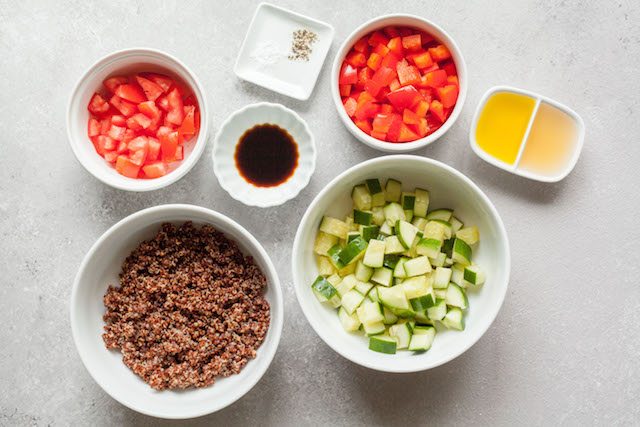
Prepare ingredients.
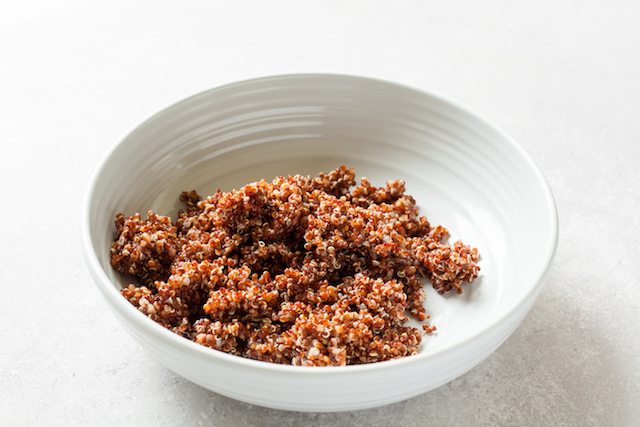
Add your prepared quinoa to a bowl.
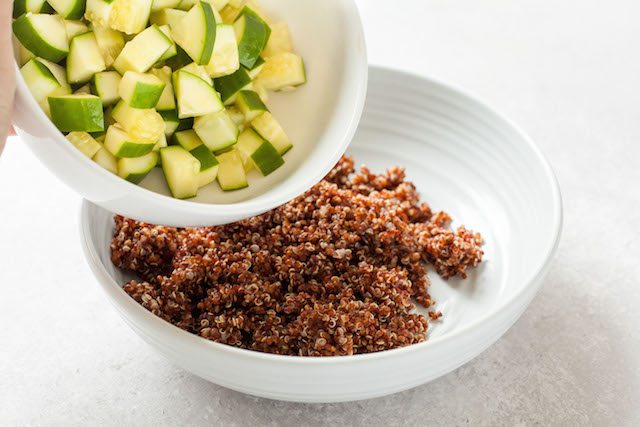
Add the diced cucumber.
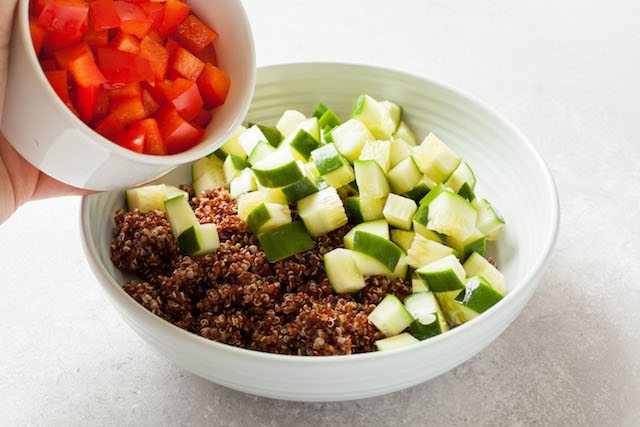
Add the diced red pepper.
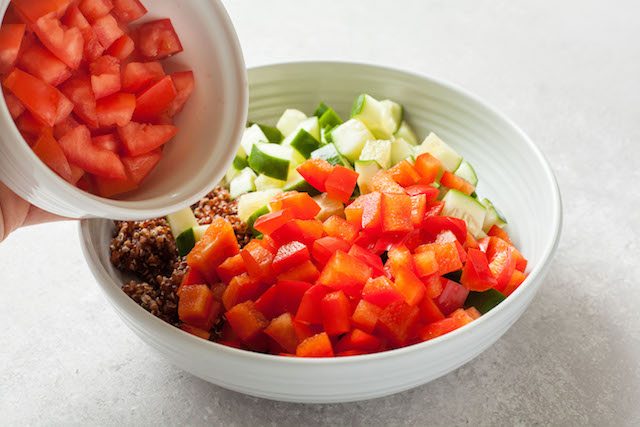
Add the diced tomatoes.
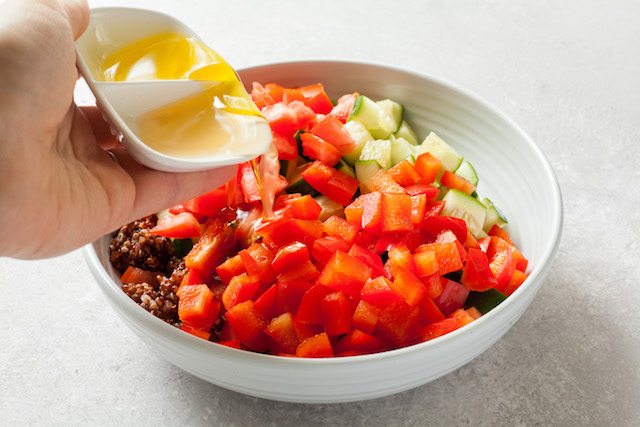
Add the olive oil and apple cider vinegar.
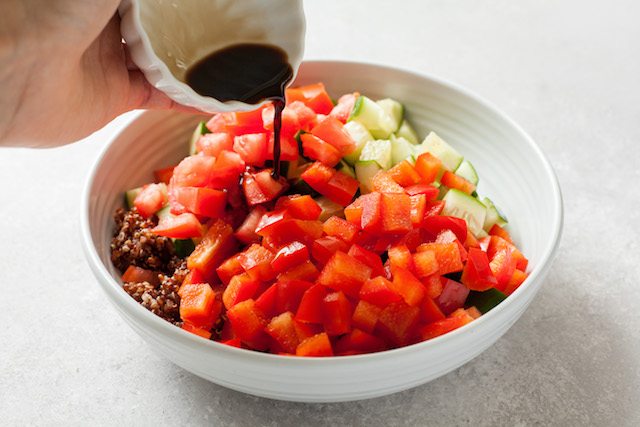
Add the balsamic vinegar.
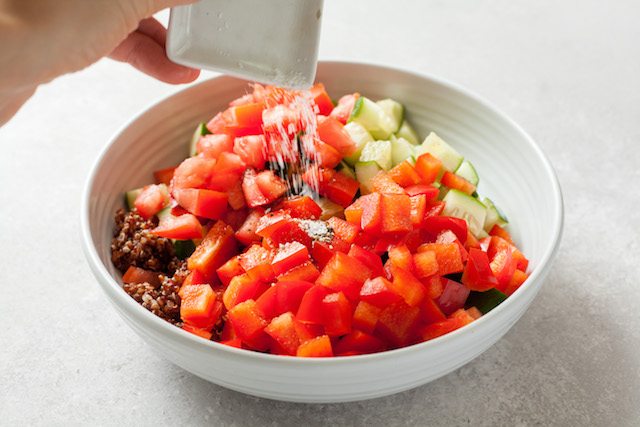
Add a pinch of salt and pepper.
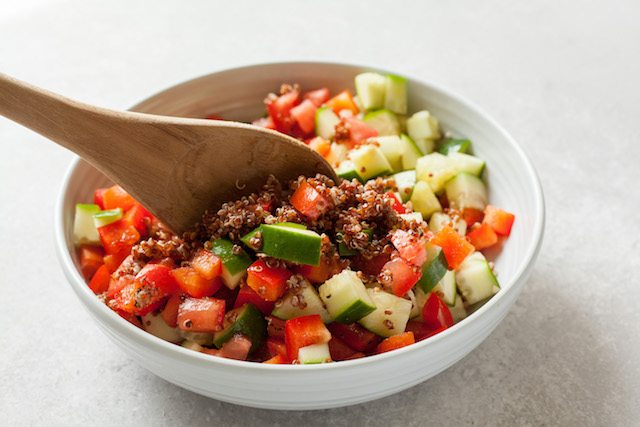
Stir all ingredients until fully combined. Adjusting seasoning if necessary.
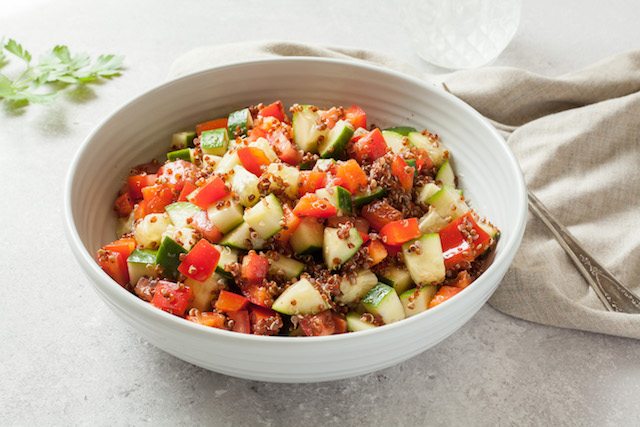
Enjoy!
See this full tasty recipe below…

Apple Cider Vinegar Veggie Quinoa Salad Recipe
Ingredients
- 1 to mato chopped
- 1 red bell pepper chopped
- 1 cucumber chopped
- 1 cup cooked red quinoa
- Vinaigrette:
- 1 tablespoons olive oil
- 1 tablespoons apple cider vinegar
- 1 teaspoon of balsamic vinegar
- Pinch of salt and pepper
Instructions
- Toss all ingredients together until combined.
- Enjoy!
Let me know how you enjoyed this recipe in the comments below, and be sure to use #beautydetoxrecipe. I love hearing your thoughts and feedback on making your own creations!
Keep this recipe handy by adding it to your Dinner Recipes Pinterest Board!
See you back here soon. Lots of love,
Kimberly

Love from magical Kyoto, Japan (that’s the edge of the Golden Temple in the background). On a side note, it’s a good reminder for all of us not to be too attached to anything material- things come and go! Here I’m wearing my favorite hat in the world, but I lost it somewhere along the way in Japan :(. I was bummed for a minute, but then reminded myself that all is fleeting, and it is okay to just breathe and let things go and keep focus on much more important things, ie love. :) Sending you love also! xo

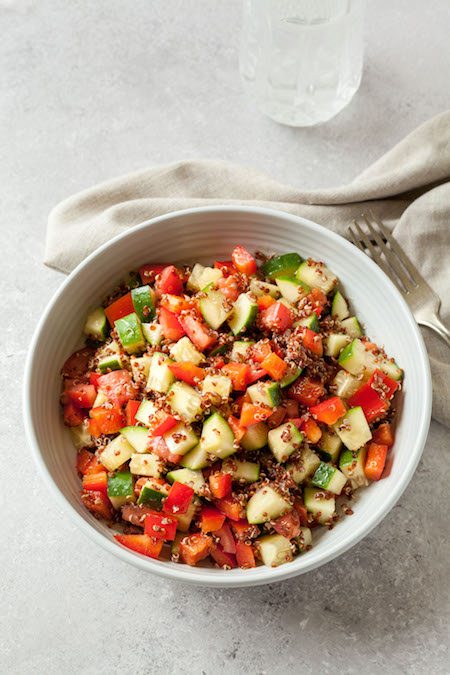

0 Comments